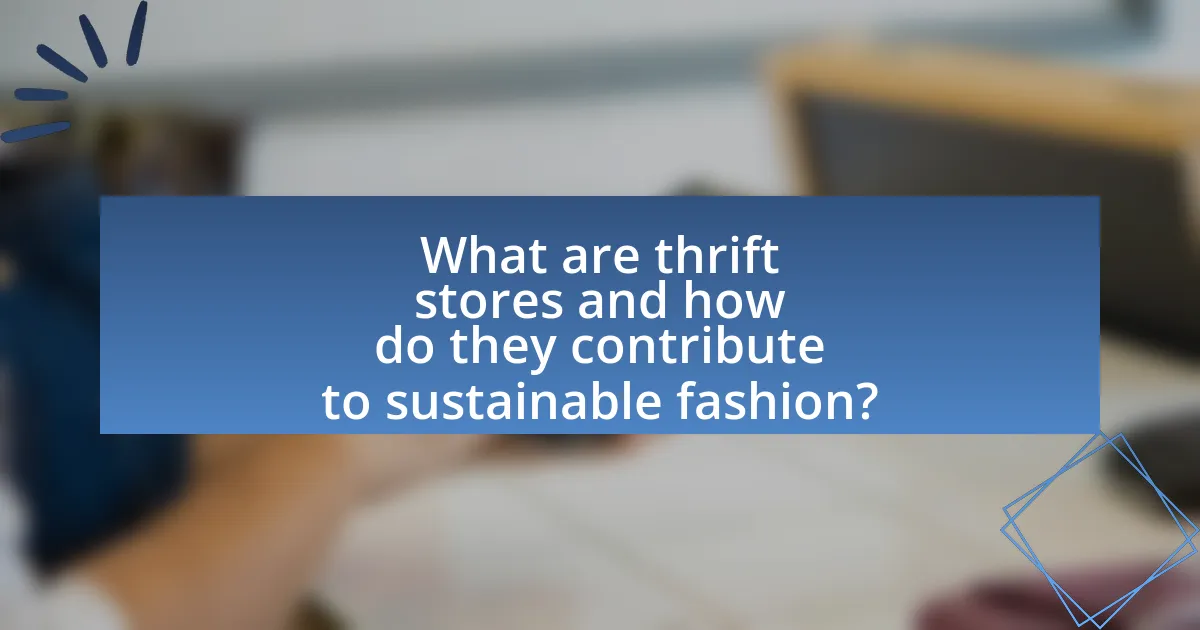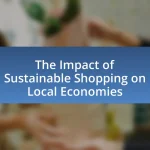Thrift stores are retail establishments that sell second-hand goods, primarily clothing, at reduced prices, playing a vital role in promoting sustainable fashion by extending the lifecycle of garments and reducing textile waste. The article explores the evolution of thrift stores from charitable organizations to popular retail options, driven by economic factors and changing consumer attitudes towards sustainability. It highlights the environmental impacts of fast fashion, the benefits of thrift shopping, and the role of shopping villages in fostering community engagement around sustainable practices. Additionally, the article discusses challenges faced by thrift stores, strategies for adaptation, and the importance of consumer support in ensuring their longevity and promoting sustainable fashion initiatives.

What are thrift stores and how do they contribute to sustainable fashion?
Thrift stores are retail establishments that sell second-hand goods, primarily clothing, at reduced prices. They contribute to sustainable fashion by promoting the reuse of garments, which reduces waste and the demand for new clothing production. According to the Environmental Protection Agency, textile waste accounts for approximately 17 million tons in landfills annually, and thrift stores help mitigate this by extending the lifecycle of clothing. By encouraging consumers to buy pre-owned items, thrift stores play a crucial role in decreasing the environmental impact associated with the fashion industry, which is known for its significant carbon footprint and resource consumption.
How have thrift stores evolved over time?
Thrift stores have evolved from small, community-based shops primarily focused on providing affordable clothing to a broader retail phenomenon that emphasizes sustainability and fashion. Initially, thrift stores emerged in the early 20th century as charitable organizations aimed at supporting social causes, with items donated by individuals. Over time, particularly from the 1980s onward, they began to attract a more diverse customer base, including those seeking unique fashion items and environmentally conscious consumers. This shift was driven by a growing awareness of fast fashion’s environmental impact, leading to increased popularity of thrift shopping as a sustainable alternative. In recent years, thrift stores have also embraced online platforms, expanding their reach and accessibility, which has further solidified their role in promoting sustainable fashion practices.
What historical factors led to the rise of thrift stores?
The rise of thrift stores can be attributed to several historical factors, including economic downturns, the environmental movement, and changing consumer attitudes towards sustainability. Economic recessions, such as the Great Depression in the 1930s and the 2008 financial crisis, led to increased demand for affordable clothing options, prompting the growth of thrift stores as a viable shopping alternative. Additionally, the environmental movement that gained momentum in the late 20th century raised awareness about the negative impacts of fast fashion, encouraging consumers to seek more sustainable shopping practices. This shift in consumer behavior has been supported by statistics indicating that second-hand shopping reduces waste and promotes recycling, further solidifying thrift stores’ role in promoting sustainable fashion.
How do thrift stores differ from traditional retail outlets?
Thrift stores differ from traditional retail outlets primarily in their sourcing and pricing models. Thrift stores typically sell second-hand items donated by individuals, which allows them to offer products at significantly lower prices compared to traditional retail outlets that sell new merchandise sourced from manufacturers. This model not only promotes affordability but also supports sustainability by extending the lifecycle of clothing and goods, reducing waste. According to the Environmental Protection Agency, reusing and recycling textiles can divert millions of tons of waste from landfills each year, highlighting the environmental benefits of thrift shopping.
Why is sustainable fashion important in today’s society?
Sustainable fashion is important in today’s society because it addresses environmental degradation and promotes ethical labor practices. The fashion industry is responsible for approximately 10% of global carbon emissions and significant water pollution, making sustainable practices essential for reducing ecological harm. Additionally, sustainable fashion emphasizes fair wages and safe working conditions, countering the exploitation often found in fast fashion. By choosing sustainable options, consumers can contribute to a circular economy, reducing waste and encouraging responsible consumption.
What environmental impacts does fast fashion have?
Fast fashion significantly contributes to environmental degradation through excessive resource consumption, pollution, and waste generation. The industry is responsible for approximately 10% of global carbon emissions, primarily due to the energy-intensive processes involved in manufacturing and transporting garments. Additionally, fast fashion generates around 92 million tons of textile waste annually, much of which ends up in landfills, where it can take decades to decompose. The production of these garments also leads to water pollution, as toxic dyes and chemicals are often released into waterways, harming aquatic ecosystems. Furthermore, the fast fashion model encourages overconsumption, exacerbating the depletion of natural resources such as water and fossil fuels.
How does thrift shopping reduce waste and promote recycling?
Thrift shopping reduces waste and promotes recycling by extending the lifecycle of clothing and household items, thereby minimizing the amount of waste sent to landfills. When consumers purchase second-hand goods, they prevent these items from being discarded, which contributes to a significant reduction in textile waste; for instance, the Environmental Protection Agency reported that in 2018, over 11 million tons of textile waste were generated in the U.S. alone. Additionally, thrift stores often resell items that might otherwise be thrown away, encouraging a culture of reuse and recycling within communities. This practice not only conserves resources but also reduces the demand for new products, which in turn lowers the environmental impact associated with manufacturing and transporting new goods.
What role do shopping villages play in promoting thrift stores?
Shopping villages play a significant role in promoting thrift stores by creating a curated shopping environment that attracts consumers interested in sustainable fashion. These villages often feature a mix of retail options, including thrift stores, which enhances visibility and accessibility for eco-conscious shoppers. By positioning thrift stores alongside other lifestyle and fashion retailers, shopping villages foster a community that values sustainability, encouraging more people to explore second-hand shopping. Research indicates that shopping villages can increase foot traffic, leading to higher sales for thrift stores, as they benefit from the collective marketing and shared customer base within the village.
How do shopping villages create a community around sustainable fashion?
Shopping villages create a community around sustainable fashion by providing a collaborative space where local artisans, thrift stores, and eco-friendly brands can showcase their products and share their values. These shopping villages often host events, workshops, and markets that educate consumers about sustainable practices and promote the benefits of second-hand shopping. For instance, studies show that communities engaged in sustainable fashion initiatives report increased awareness and participation in eco-friendly practices, leading to a stronger collective identity focused on sustainability. By fostering connections among consumers, businesses, and advocates, shopping villages effectively cultivate a supportive environment that encourages sustainable fashion choices.
What benefits do shopping villages offer to thrift stores and consumers?
Shopping villages provide significant benefits to thrift stores and consumers by creating a collaborative retail environment that enhances visibility and foot traffic. Thrift stores located within shopping villages often experience increased customer access due to the concentration of various shops, which attracts a diverse range of shoppers. This increased exposure can lead to higher sales volumes, as consumers are more likely to browse multiple stores during their visit.
Additionally, shopping villages often promote a sense of community and sustainability, aligning with the values of thrift store shoppers who prioritize eco-friendly practices. The presence of multiple thrift stores within a shopping village can foster a culture of sustainable fashion, encouraging consumers to make environmentally conscious purchasing decisions. This synergy not only benefits thrift stores through shared marketing efforts and events but also educates consumers about the importance of sustainable shopping habits.
How can consumers support thrift stores and sustainable fashion?
Consumers can support thrift stores and sustainable fashion by purchasing second-hand items, donating unwanted clothing, and promoting awareness of the environmental benefits of thrift shopping. Buying second-hand reduces waste and extends the lifecycle of clothing, which is crucial as the fashion industry is responsible for 10% of global carbon emissions. Additionally, donating clothing to thrift stores helps keep textiles out of landfills, with the EPA reporting that in 2018, 11.3 million tons of textile waste were generated in the U.S. By advocating for thrift shopping through social media and community events, consumers can further encourage sustainable practices and support local economies.
What are the best practices for shopping at thrift stores?
The best practices for shopping at thrift stores include researching store locations, visiting frequently, and checking for sales or discounts. Researching store locations helps identify the best options in terms of inventory and pricing. Frequent visits increase the chances of finding unique items, as thrift store inventory changes regularly. Additionally, many thrift stores offer sales or special discount days, which can significantly reduce costs. According to a 2021 report by ThredUp, 70% of thrift shoppers believe that shopping secondhand is more sustainable, reinforcing the importance of these practices in promoting sustainable fashion.
How can consumers spread awareness about sustainable fashion initiatives?
Consumers can spread awareness about sustainable fashion initiatives by actively participating in and promoting thrift store events and campaigns. Engaging in social media discussions, sharing personal experiences with thrift shopping, and using relevant hashtags can amplify the message. Research indicates that 66% of consumers are willing to pay more for sustainable brands, highlighting the importance of consumer advocacy in driving awareness and change in the fashion industry. By collaborating with local thrift stores and sustainable fashion organizations, consumers can help create community events that educate others about the benefits of sustainable fashion practices.

What challenges do thrift stores face in the current market?
Thrift stores face significant challenges in the current market, primarily due to increased competition from online resale platforms and changing consumer preferences. The rise of e-commerce giants like Poshmark and Depop has made it easier for consumers to buy and sell second-hand items, which diverts potential customers away from physical thrift stores. Additionally, the COVID-19 pandemic has altered shopping habits, with many consumers preferring the convenience of online shopping over in-store experiences. According to a report by ThredUp, the second-hand market is projected to reach $64 billion by 2024, highlighting the growing competition thrift stores must navigate. Furthermore, thrift stores often struggle with inventory management, as the influx of donations can lead to overstocking, while also facing challenges in maintaining quality and appealing merchandise to attract customers.
How do economic factors impact thrift store operations?
Economic factors significantly impact thrift store operations by influencing donation levels, pricing strategies, and consumer purchasing behavior. For instance, during economic downturns, individuals may donate more items as they declutter or face financial constraints, increasing inventory for thrift stores. Conversely, when the economy is strong, consumers may prefer new goods, leading to decreased donations and sales. Additionally, thrift stores often adjust their pricing based on economic conditions; lower prices during tough times can attract budget-conscious shoppers. According to a 2021 report by the National Association of Resale Professionals, thrift store sales increased by 25% during economic recessions, highlighting the correlation between economic factors and thrift store performance.
What role does competition from online retailers play?
Competition from online retailers significantly influences thrift stores by driving them to enhance their pricing strategies and customer experience. As online platforms often offer lower prices and greater convenience, thrift stores must adapt by curating unique inventory and improving in-store engagement to attract customers. For instance, a study by the National Association of Resale and Thrift Shops found that 70% of thrift store owners reported increased competition from online retailers as a primary challenge, prompting them to innovate and differentiate their offerings. This competition ultimately encourages thrift stores to promote sustainable fashion more effectively by emphasizing their unique value propositions, such as one-of-a-kind items and community involvement.
How can thrift stores adapt to changing consumer preferences?
Thrift stores can adapt to changing consumer preferences by enhancing their online presence and curating inventory that reflects current fashion trends. By establishing e-commerce platforms, thrift stores can reach a broader audience, catering to consumers who prefer shopping online. Additionally, data from the ThredUp 2021 Resale Report indicates that 70% of consumers are interested in sustainable fashion, suggesting that thrift stores should focus on promoting their eco-friendly practices and unique, trendy items to attract environmentally conscious shoppers.
What strategies can thrift stores implement to thrive?
Thrift stores can thrive by implementing effective marketing strategies, enhancing customer experience, and optimizing inventory management. Marketing strategies such as social media engagement and community events can attract a broader customer base, as evidenced by a 2021 survey indicating that 60% of thrift shoppers are influenced by social media promotions. Enhancing customer experience through organized layouts and friendly staff can lead to increased sales; research shows that a positive shopping environment boosts customer retention by up to 30%. Additionally, optimizing inventory management by using data analytics to track trends and customer preferences can ensure that stores stock desirable items, which is crucial since 70% of thrift store revenue comes from high-demand products.
How can marketing and community engagement enhance thrift store visibility?
Marketing and community engagement can significantly enhance thrift store visibility by creating awareness and fostering relationships with local consumers. Effective marketing strategies, such as social media campaigns and local advertising, can reach a broader audience, showcasing unique products and promoting special events. Community engagement initiatives, like partnerships with local organizations or hosting workshops, can build trust and encourage community members to support the thrift store. According to a study by the National Association of Resale and Thrift Shops, stores that actively engage with their communities see a 30% increase in foot traffic compared to those that do not. This demonstrates that a combination of targeted marketing and community involvement directly correlates with increased visibility and customer loyalty for thrift stores.
What partnerships can thrift stores form to boost sustainability efforts?
Thrift stores can form partnerships with local environmental organizations to enhance sustainability efforts. Collaborating with these organizations allows thrift stores to participate in community clean-up events, recycling initiatives, and educational programs that promote sustainable practices. For instance, partnerships with non-profits focused on waste reduction can help thrift stores implement better recycling protocols and increase awareness about the environmental benefits of second-hand shopping. Additionally, collaborating with local businesses can facilitate clothing drives and donation events, further promoting a circular economy. These partnerships not only strengthen community ties but also amplify the thrift store’s commitment to sustainability, as evidenced by studies showing that community engagement significantly boosts local support for eco-friendly initiatives.

What future trends can we expect in the thrift store industry?
The thrift store industry is expected to see a significant increase in online sales and digital integration. As consumers increasingly prioritize sustainability, thrift stores are adapting by enhancing their online presence through e-commerce platforms and social media marketing. According to a report by ThredUp, the secondhand market is projected to reach $64 billion by 2024, driven by a growing consumer preference for sustainable shopping options. Additionally, thrift stores are likely to implement more innovative inventory management systems, utilizing data analytics to optimize stock and improve customer experience. This trend aligns with the broader shift towards sustainable fashion, as thrift stores become key players in promoting eco-friendly shopping habits.
How is technology influencing thrift shopping experiences?
Technology is significantly enhancing thrift shopping experiences by providing online platforms and mobile applications that facilitate easier access to second-hand goods. These digital tools allow consumers to browse inventory, compare prices, and make purchases from the comfort of their homes, increasing convenience and expanding the reach of thrift stores. For instance, platforms like ThredUp and Poshmark have reported substantial growth, with ThredUp’s 2021 Resale Report indicating that the second-hand market is projected to reach $64 billion by 2024, driven largely by online sales. Additionally, social media marketing enables thrift stores to engage with a broader audience, showcasing unique items and promoting sustainable fashion practices, which aligns with the growing consumer demand for eco-friendly shopping options.
What innovations are being introduced in thrift store operations?
Thrift store operations are introducing innovations such as online sales platforms, mobile apps for inventory management, and enhanced customer experience through technology. These advancements allow thrift stores to reach a broader audience, streamline their operations, and improve customer engagement. For instance, the integration of e-commerce has enabled stores to sell items online, significantly increasing their sales potential; a report from ThredUp indicates that the online resale market is projected to reach $64 billion by 2024. Additionally, mobile apps facilitate efficient inventory tracking and donation management, optimizing the operational workflow of thrift stores.
How can social media impact thrift store popularity?
Social media significantly enhances thrift store popularity by increasing visibility and engagement among potential customers. Platforms like Instagram and TikTok allow thrift stores to showcase unique items, share styling tips, and promote sustainable fashion, attracting a broader audience. For instance, a study by the Thrift Store Association found that thrift stores with active social media accounts saw a 30% increase in foot traffic compared to those without. This demonstrates that social media not only raises awareness but also drives consumer interest and sales in thrift stores.
What can consumers do to ensure the longevity of thrift stores?
Consumers can ensure the longevity of thrift stores by consistently shopping at them and donating quality items. Regular patronage increases sales, which are vital for the operational sustainability of thrift stores. According to the National Association of Resale and Thrift Shops, thrift stores contribute significantly to local economies, with many reporting that increased consumer support leads to higher revenue and the ability to expand services. Additionally, donating gently used items helps maintain inventory levels, ensuring that thrift stores can continue to offer a diverse selection of goods. This cycle of shopping and donating fosters a sustainable model that benefits both consumers and the environment.
How can individuals advocate for sustainable fashion in their communities?
Individuals can advocate for sustainable fashion in their communities by organizing local events that promote thrift shopping and sustainable practices. These events can include clothing swaps, workshops on upcycling, and educational sessions about the environmental impact of fast fashion. Research indicates that community engagement in sustainable practices can significantly increase awareness and participation; for instance, a study by the Ellen MacArthur Foundation highlights that promoting circular fashion can reduce textile waste by up to 80%. By actively participating in and promoting these initiatives, individuals can foster a culture of sustainability and encourage others to make conscious fashion choices.
What are the key takeaways for supporting thrift stores effectively?
To support thrift stores effectively, individuals should prioritize donating quality items, shopping regularly, and promoting awareness of thrift store benefits. Quality donations ensure that thrift stores can offer desirable products, which attracts more customers and increases sales. Regular shopping helps sustain the store’s revenue, as consistent patronage is crucial for their financial health. Additionally, raising awareness about the environmental and economic advantages of thrift shopping can encourage more people to participate, thereby enhancing the overall impact of thrift stores in promoting sustainable fashion.


